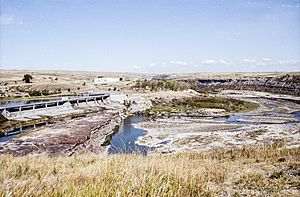Rainbow Falls (Missouri River) facts for kids
Quick facts for kids Rainbow Falls |
|
|---|---|

Rainbow Falls and Rainbow Dam in 2000
|
|
| Lua error in Module:Infobox_mapframe at line 185: attempt to index field 'wikibase' (a nil value). | |
| Location | Cascade County, Montana, United States |
| Type | Block |
| Total height | 47 feet |
| Number of drops | 1 |
| Total width | 1,320 feet |
Rainbow Falls is a beautiful waterfall located on the Missouri River in Great Falls, Montana. It was once called "Handsome Falls." This waterfall is just a bit upstream from Crooked Falls and downstream from Colter Falls and the Rainbow Dam.
Rainbow Falls is quite large, standing 47 feet (about 14 meters) tall and stretching 1,320 feet (about 402 meters) wide. It's one of the five amazing Great Falls of the Missouri. The river flows over a flat rock ledge made of sandstone, creating the waterfall.
In the past, the falls always had a lot of water flowing over them. But in 1914, a dam called the Rainbow Dam was built a little upstream. This dam helps create electricity from the river's power. Because of the dam, the falls can sometimes look almost dry in the summer. Only small streams of water might trickle down its face. A railroad bridge also crosses the river right above the falls.
How Rainbow Falls Looks
Rainbow Falls changes a lot depending on the time of year. In spring, when there's a lot of water, the falls look very full and powerful, much like they did long ago. This is especially true on the right side, where water flows out from the dam, and on the left side, where the main spillway (a channel for water) is.
The middle part of the dam only lets water through when there's too much flow in the river. The left side of the falls has been worn away more by water than the right side. It also sits a little further upstream. Tall, dry hills rise above the river canyon on both sides. Below the falls, there's a long, narrow pool of water and some gravel areas.
As the water flow over the falls gets lower, usually from summer to early autumn, it splits into two main parts. These parts hug both sides of the riverbanks. Even then, the water usually still covers about 70 percent of the river's width. The middle section might become dry, except for a small stream that appears when the water is low enough to separate it from the left side, but still high enough to feed it. The river below the falls usually stays mostly full.
Water Flow and Power
In the autumn, most of the river's water is sent through large pipes called penstocks. These pipes go around the right side of the falls. The water then continues downstream past Crooked Falls, which is about 19 feet (5 meters) high. The combined drop of over 70 feet (21 meters) helps create hydroelectricity using 8 turbines.
During this time, Rainbow Falls itself might only have a tiny trickle of water. Some water still flows down the right side of the falls in a few small, parallel streams from the dam's outlet. On the right, there are also two small drops, each about 10 feet (3 meters) wide when the water is low. Also, water comes out of a pipe on the left side of the falls, trickling into the river as a series of small waterfalls.
Upstream from Rainbow Falls are Colter Falls and Black Eagle Falls. Colter Falls is now covered by the water held back by Rainbow Dam. Black Eagle Falls is also controlled by a dam, similar to Rainbow Falls. Downstream from Rainbow Falls are Crooked Falls and the Grand Falls of the Missouri. Crooked Falls is mostly in its natural state, except for some changes on its right side where the penstocks were built. Grand Falls is also affected by a dam, much like Rainbow and Black Eagle falls. However, unlike Black Eagle and Grand Falls, which were partly changed by power canals, Rainbow Falls still looks very much like it did naturally.
History of the Falls
Rainbow Falls was first discovered by the famous Lewis and Clark Expedition. Rainbow Falls and Crooked Falls (downstream) are the only two waterfalls on the Missouri-Mississippi river system that are still mostly in their natural state. Black Eagle Falls and Great Falls have large powerhouses built on them, and Colter Falls is completely underwater.
The waterfall got its name because rainbows often appeared in its misty spray before the dams were built.
Meriwether Lewis, one of the leaders of the expedition, wrote about the falls:
... hearing a tremendious roaring above me I continued ... a few hundred yards further and was again presented by one of the most bea[utiful]objects in nature, a cascade of about fifty feet perpendicular stre[t]ching at [right angles] across the river from side to side to the distance of at least a quarter of a mile. here the river pitches over a shelving rock, with an edge as regular and streight as if formed by art, without a nich[e] or br[eak] in it; the water descends in one even and uninterrupted sheet . . .
Lewis first called the waterfall "Beautiful Cascade" and later "Handsom[e] Falls." But in 1872, a railroad engineer named Thomas Paschall Roberts gave it its current name, Rainbow Falls.

